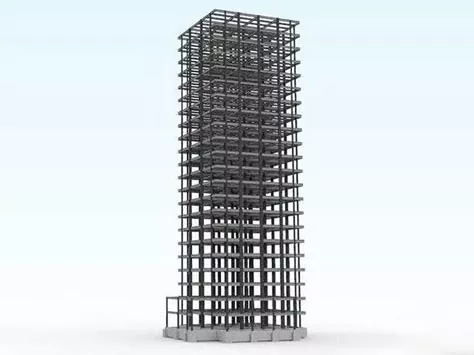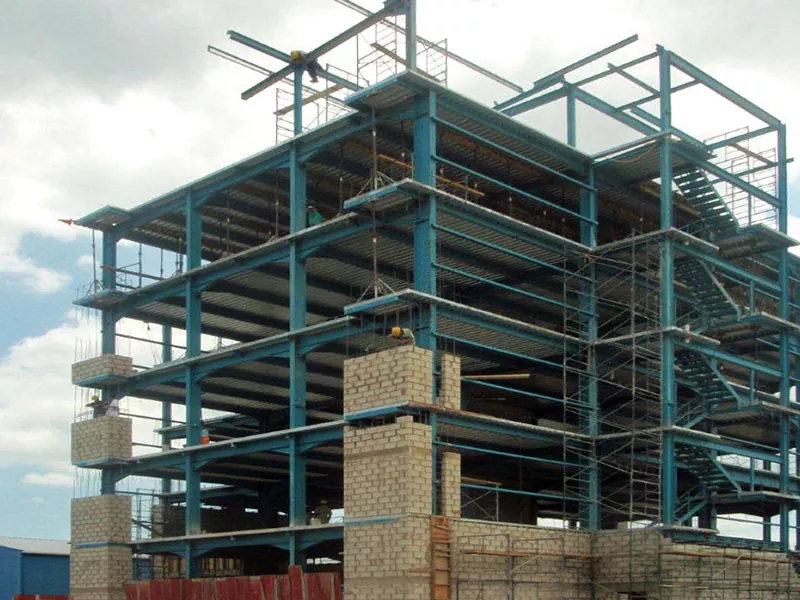QR Code

EIHE Steel Structure’s A high-rise steel frame office building represents a pinnacle of modern architecture and engineering, offering a blend of functionality, efficiency, and aesthetics. These towering structures are designed to maximize space utilization within a compact footprint, making them ideal for bustling urban centers where land is scarce and valuable.
The steel frame serves as the backbone of the building, providing both structural support and stability. It is typically composed of a series of vertical columns and horizontal beams that are interconnected to form a rigid grid. This gridwork distributes the weight of the building and its contents evenly across the entire structure, ensuring that it remains standing even under heavy loads or extreme weather conditions.
One of the key advantages of using steel for the framing system of a high-rise office building is its strength-to-weight ratio. Steel is a highly durable material that can withstand significant stresses and strains without failing. As a result, steel frame buildings can be designed to be taller and more slender than those constructed using other materials, such as concrete or timber.
Another advantage of steel frame construction is its flexibility. Steel frames can be easily modified or extended to accommodate changes in the building's use or design over time. This makes them particularly well-suited for office buildings, which often undergo renovations or expansions as the needs of the tenants evolve.
In addition to these practical advantages, steel frame office buildings are also often prized for their aesthetic appeal. The clean, modern lines of a steel frame can be accented with a variety of cladding materials, such as glass, stone, or metal panels, to create a sleek and sophisticated appearance.
Overall, high-rise steel frame office buildings are an efficient and attractive option for organizations seeking to establish a strong presence in an urban environment. They offer a combination of strength, durability, and flexibility that makes them well-suited for a wide range of uses and applications.
High-rise steel frame office buildings are complex structures that require careful planning, design, and construction. Here are some detailed aspects of these buildings:
1. Structural Design
● Steel Frame System: The backbone of a high-rise steel frame office building is its steel framing system. This system comprises vertical columns and horizontal beams, interconnected to form a rigid grid that supports the entire structure. Steel is chosen for its strength, durability, and versatility, allowing for the creation of tall, slender buildings with excellent seismic performance.
● Design Flexibility: Steel frames offer unparalleled design flexibility. Architects and engineers can customize the framing system to meet the unique requirements of each project, including the number of floors, the size and layout of individual spaces, and the overall shape and appearance of the building.
2. Building Materials
● Steel Types: High-strength, low-alloy (HSLA) steels are commonly used in high-rise steel frame office buildings due to their excellent mechanical properties and cost-effectiveness. These steels are specifically designed to withstand the rigors of high-rise construction, including wind loads, seismic forces, and temperature variations.
● Connections: Steel frame connections are critical to the overall stability and performance of the building. They are typically designed to be rigid or semi-rigid, depending on the specific requirements of the project. Welded and bolted connections are commonly used, with each method offering its own advantages and disadvantages.
3. Construction Process
● Prefabrication: Many components of a high-rise steel frame office building, including beams, columns, and connections, are prefabricated in a factory setting. This approach reduces construction time and improves quality control, as the components are manufactured to precise specifications under controlled conditions.
● Erection: Once the prefabricated components are delivered to the construction site, they are erected using cranes and other heavy equipment. The erection process is carefully planned and coordinated to ensure the safety of workers and the stability of the structure.
● Finishing: After the steel frame is complete, the building is enclosed with exterior cladding (such as glass, metal, or concrete panels) and fitted with interior finishes (such as drywall, carpeting, and lighting). This phase of construction completes the transformation of the steel frame into a fully functional office building.
4. Environmental Considerations
● Sustainability: High-rise steel frame office buildings are often designed with sustainability in mind. Steel is a highly recyclable material, and the use of steel framing systems can help reduce waste and minimize the environmental impact of construction projects.
● Energy Efficiency: The energy efficiency of these buildings is often enhanced through the use of advanced insulation, glazing, and HVAC systems. These systems can help to reduce energy consumption and lower operating costs, making the buildings more attractive to tenants and investors.
5. Safety and Durability
● Fire Resistance: Steel frame buildings are inherently fire-resistant, as steel does not burn or contribute to the spread of fire. However, additional fire protection measures, such as fire-resistant coatings and sprinkler systems, may be required to meet local fire safety regulations.
● Seismic Performance: Steel frame buildings are well-suited for seismic regions due to their ability to withstand lateral forces. The use of bracing systems, shear walls, and other seismic-resistant features can further enhance the seismic performance of these buildings.
In summary, high-rise steel frame office buildings are complex structures that require careful planning, design, and construction. Their steel framing systems offer unparalleled strength, durability, and design flexibility, making them a popular choice for modern office buildings. Additionally, their environmental considerations, energy efficiency, and safety features make them an attractive option for businesses seeking to create a sustainable and productive work environment.
1. How are steel frame connections designed and constructed?
Answer:
When designing a steel structure tower, several key considerations must be taken into account:
Steel frame connections are critical to the overall stability and performance of the building. They are typically designed to be rigid or semi-rigid, depending on the specific requirements of the project.
Welded and bolted connections are commonly used in high-rise steel frame office buildings. Welded connections are strong and reliable, but they require skilled labor and can be difficult to inspect for quality. Bolted connections, on the other hand, are easier to inspect and can be tightened during construction to ensure proper alignment and tightness.
2.What are some considerations for fire safety in high-rise steel frame office buildings?
Answer:
Although steel is inherently fire-resistant, additional fire protection measures may be required to meet local fire safety regulations.
Fire-resistant coatings can be applied to steel components to improve their fire resistance.
Sprinkler systems and other fire suppression systems can be installed to control and extinguish fires in the building.
Regular fire safety inspections and training for building occupants and emergency responders are also important to ensure the safety of the building and its occupants.
3.How do high-rise steel frame office buildings withstand seismic forces?
Answer:High-rise steel frame office buildings are designed to withstand seismic forces (such as earthquakes) by incorporating various engineering techniques and materials. This may include the use of special moment frames, which are designed to absorb and dissipate energy during an earthquake. The steel frame is also connected to the foundation in a way that allows for some movement, reducing the risk of structural damage. Additionally, seismic isolation systems can be installed beneath the building to further isolate it from ground shaking.
4.What are the environmental benefits of using steel frames in high-rise office buildings?
Answer:Steel frames offer several environmental benefits in high-rise office buildings. Firstly, steel is a highly recyclable material, and the use of steel framing systems can help reduce waste and minimize the environmental impact of construction projects. Steel is also durable, meaning that high-rise steel frame buildings have a long service life and require fewer repairs and replacements over time. Additionally, steel frames can be designed to incorporate sustainable features, such as green roofs, solar panels, and high-performance glazing, which can help reduce the building's energy consumption and carbon footprint.
5. How do high-rise steel frame office buildings impact urban planning and development?
Answer:High-rise steel frame office buildings can have a significant impact on urban planning and development. They can help to increase the density of urban areas, reducing the need for sprawl and preserving green spaces. Additionally, high-rise buildings can provide a focal point for urban development, attracting businesses and residents to a particular area. However, high-rise buildings can also create challenges, such as increased traffic congestion and shadowing of adjacent buildings, which must be carefully considered during the planning and design process. Overall, the impact of high-rise steel frame office buildings on urban planning and development will depend on the specific context and goals of the project.


Address
No. 568, Yanqing First Class Road, Jimo High-tech Zone, Qingdao City, Shandong Province, China
Tel

Copyright © 2024 Qingdao Eihe Steel Structure Group Co., Ltd. All Rights Reserved.
Links | Sitemap | RSS | XML | Privacy Policy |
TradeManager
Skype
VKontakte
